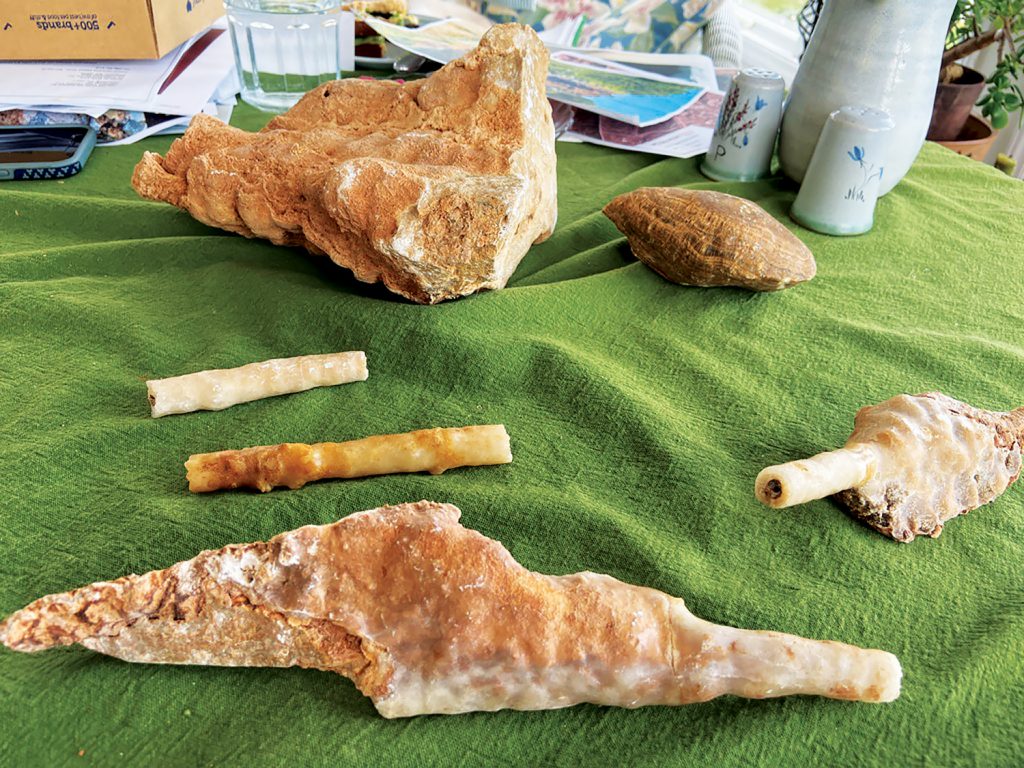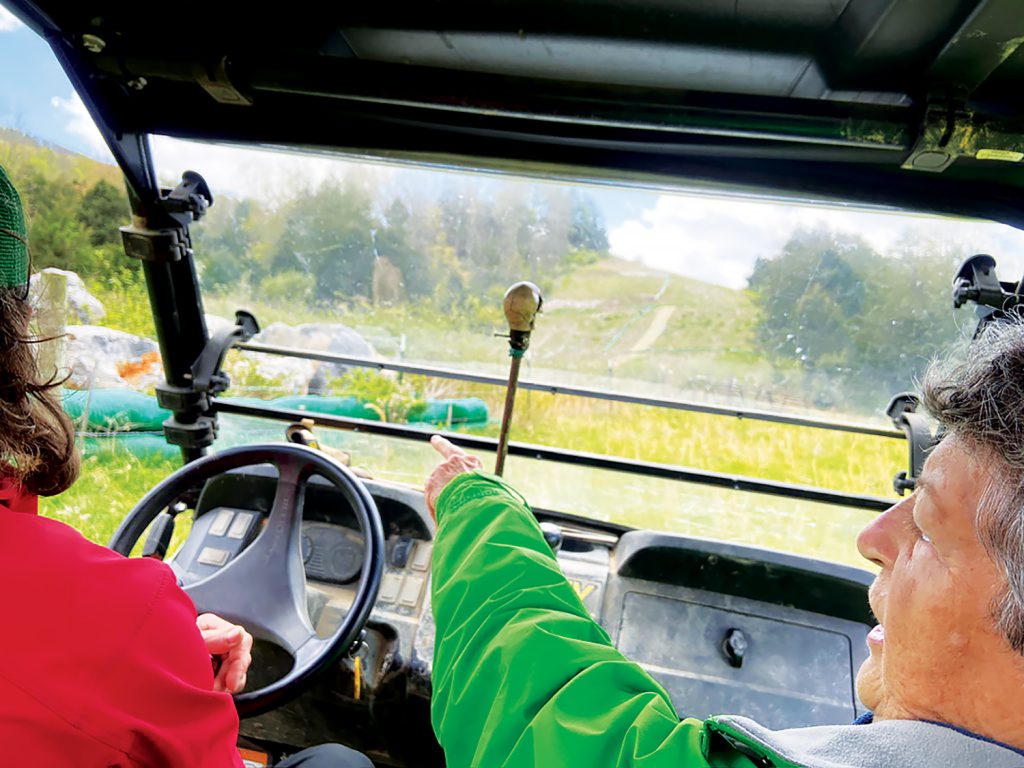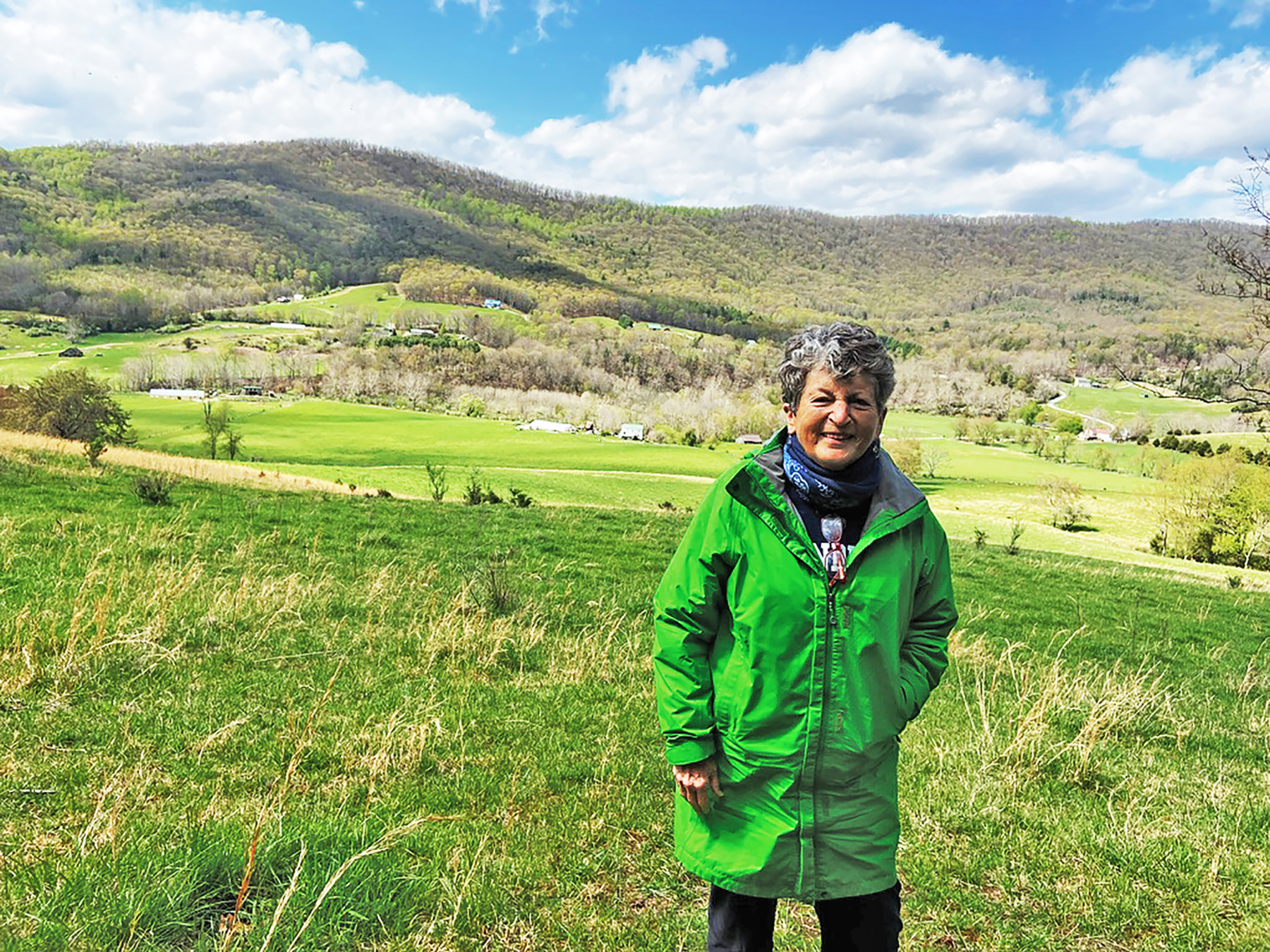Woman Says Pipeline ‘Wrecked’ Farm
By Dan Radmacher
Karolyn Givens sat at a table in her sunroom, nibbling on one of the sandwiches she had prepared for visitors. The table was stacked with papers, photographs and notes — and a big box of rocks.
The rocks were stalagmites, stalactites and other forms that would tell a geologist they came from a cave — a cave on Karolyn Givens’ farm that Mountain Valley Pipeline insisted didn’t exist.
And now it doesn’t.
Givens says the cave was in the right of way MVP carved through her farm over her objections.
“They blew it up,” she says. “They blew it up and filled it in with shrink-filled clay. I told them, ‘You’re going to wreck my water.’”
Will Orndorff, karst protection coordinator for the Virginia Natural Heritage program in the Department of Conservation and Recreation, doesn’t believe MVP destroyed a cave.
“We never found evidence of cave passages,” he says. “We never found anything like a currently existing cave.”
He says it’s more likely the initial cut for the right of way hit an already unroofed cave, though he admits, “We couldn’t say conclusively there was nothing there.”
Mountain Valley Pipeline did not respond to requests for comment.

These rocks found during Mountain Valley Pipeline’s work on the right-of-way suggest the presence of a cave on Karolyn Givens’ land. Photo by Dan Radmacher
Givens remains convinced there was a cave, and its destruction is just part of the damage to her land. She talks her visitors through what happened in a quiet, determined voice, referencing notes and papers and a timeline she had prepared.
Givens and her husband, Clarence, bought the farm outside of Newport, Virginia, in 1980 as an investment. They rented out the 1836 farmhouse on the property, grazed cattle on the land and thought one day of subdividing it and selling the parcels.
“We thought it would be better than putting money in the market,” she says.
Then, in 2014, they heard about the proposed Mountain Valley Pipeline. She didn’t worry at first.
“How could they go through all these historic places?” she asks.
The route originally avoided her property.
Then the route shifted — in part, the company said, to avoid “sensitive geologic features” such as caves and sinkholes — and the farm was in the crosshairs. Clarence and Karolyn we’re gearing up to fight the project together, but in August 2017, he died suddenly and unexpectedly. A couple months later, condemnation papers informing her that MVP had secured an easement across her land were duct-taped to Givens’ front door, a packet so thick she wasn’t able to open the door.
Landowners, including Givens, went to court in January 2018 to fight MVPs attempt to take portions of their property through eminent domain, but a federal judge allowed the developer to take immediate possession of the right-of-way and begin construction.
“They just started taking it apart,” Givens says.
Givens’ farm is bisected by Sinking Creek and then rises up to the ridge of Sinking Creek Mountain. The right-of-way cuts through the woods and pastures about halfway between the creek and the ridge, a 125-foot gash through the land, now bordered on either side by erosion control barriers.

Karolyn Givens points out the large rocks left fromMountain Valley Pipeline’s blasting of the trench for the pipeline during a tour of her farm. Photo by Dan Radmacher
Drainage patterns on the land changed after the pipeline was buried and the cave was filled, changing how water moves underground. On a tour of the farm, Givens showed where the tenant renting the farmhouse had dug drainage ditches to route heavy runoff around the house and driveway. The water running into Sinking Creek from uphill is now muddy with clay.
“They wrecked it,” Givens says. “They wrecked the side of the mountain. Water runs right off it. Sinkholes are opening up and getting deeper. There’s so much erosion.”
The lower portion of the farm began flooding more often and sinkholes started to develop — “12 or 13 of them, all lined up in a neat, little row,” says Givens.
Givens’ farm, like about half of Giles County, is karst landscape — the bedrock beneath it is a combination of limestone and other types of rock. The limestone reacts to water, gradually dissolving and causing caves, sinkholes and other distinctive features. Water flow through karst can be hard to predict, and karst landscapes are prone to landslides and other instability.
Nan Gray, a soil scientist who lives a short distance from Givens’ farm, helped monitor what was happening — but watching was hard.
“I did have an emotional attachment to her land,” Gray says. “As a scientist, I separate my emotions. But what they did to her property — I almost had a nervous breakdown about her property being ruined. I realize these soils and animals and life here are all connected. What they did was put a dead zone in our very live world here. We were a no-build zone and they came in and destroyed something that is irreparable.”
The company’s attempt to replant the right-of-way hasn’t been successful, according to Gray.
“MVP couldn’t seem to make anything grow,” she says.
Gray believes the company is putting in plants that can’t handle the low acidity of the native soil. The lack of life will have consequences, she warns.
“If there is still any life left in the soil of the construction mix that they ground up and spit back out there, I don’t know, but it’s really important for us to get some life back into that right-of-way as soon as possible, or our troubles will never end,” says Gray.
Planting native grasses and plants that are accustomed to the lower soil acidity would be a good start, according to Gray.
She explained the importance of insect, plant and animal life for the soil.
“Organic matter holds the moisture to those sand-filled and clay particles. Plant and insect secretions form a biological snot that holds everything together in the soil,” says Gray. “In the right of way, there’s very little organic matter to hold the moisture and to hold the soil together.”
The consequences could be grave, according to Gray. “Those are naturally very erosive soils already,” she says. “If it fails, it’s going to muddy more than just water. It’s going to be a bad nasty.”

Sediment flows constantly into Sinking Creek on Karolyn Givens’ farm from drainage from Mountain Valley Pipeline’s right of way. Photo by Dan Radmacher.
Givens is clear about what MVP has done to her land.
“They wrecked it,” she says. “They just totally wrecked it. There’s no fixing it. I don’t want them to touch it again.”
In the next breath, she says, “We need this land back intact.”
It’s not just what MVP did to Givens’ land that angers Gray.
“The very top of the mountain is sandstone that armors the whole ridge,” says Gray. “MVP blasted the armor off the top of Sinking Creek Mountain that’s been up there for 275 million years. They blasted that off, and the water that was confined under pressure within the sandstone suddenly gushes out. I saw ice floes 45 feet to 75 feet long down the mountain.”
The water followed the pipeline route as it flowed out, causing further erosional issues.
“They’ve come into a place, a protected place, and done far more damage than they should have been allowed to do,” says Gray.
Givens agrees.
“They chewed us up and spit us out,” she says. “The super sad thing is no state agency ever came to the rescue. Nobody has helped.”
Irina Calos, a spokesperson for theVirginia Department of Environmental Quality, says her department immediately investigates any report of erosion, stormwater, stream or wetland issues associated with the pipeline and notifies MVP if corrective action is required.
“On Ms. Givens’ property, the right of way has been restored to original contours and drainage patterns,” Calos says. “MVP coordinated the restoration work with Ms. Givens, and planted the right of way with permanent vegetation.”
Givens says she’s contacted DEQ more than once.
“They never would respond in anyway that was helpful,” she says. “DEQ heard about my cave and spring water concerns and were totally uninterested.There is no way for my land to be returned to its original state.”
Gray hopes the developers eventually give up and remove the pipe in the land. “
The pipe has got to go before the land can heal,” she says. “It’s like a splinter.”
Givens would love to see an outcome like that.
“Clarence always told me, ‘Remember, it’s not over until it’s over. Don’t give up,’” she says. “Don’t give up.”
Related Articles
Latest News

Leave a comment
Your email address will not be published. Required fields are marked *






Leave a Comment